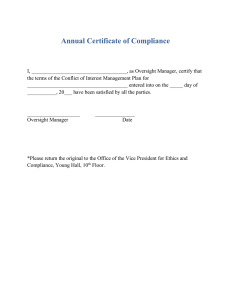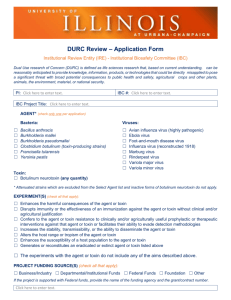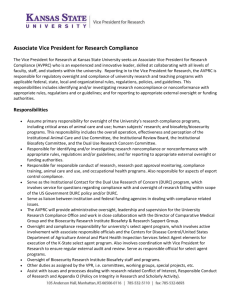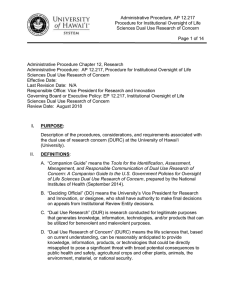Executive Policy, EP 12.217 Policy for Institutional Oversight of Life
advertisement
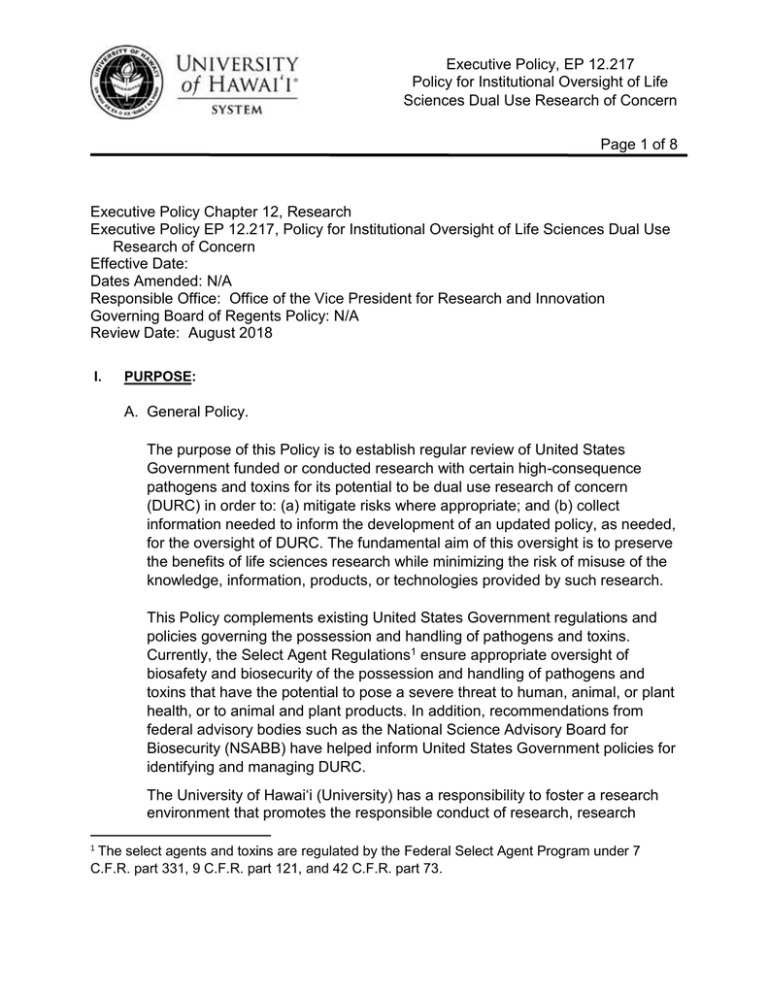
Executive Policy, EP 12.217 Policy for Institutional Oversight of Life Sciences Dual Use Research of Concern Page 1 of 8 Executive Policy Chapter 12, Research Executive Policy EP 12.217, Policy for Institutional Oversight of Life Sciences Dual Use Research of Concern Effective Date: Dates Amended: N/A Responsible Office: Office of the Vice President for Research and Innovation Governing Board of Regents Policy: N/A Review Date: August 2018 I. PURPOSE: A. General Policy. The purpose of this Policy is to establish regular review of United States Government funded or conducted research with certain high-consequence pathogens and toxins for its potential to be dual use research of concern (DURC) in order to: (a) mitigate risks where appropriate; and (b) collect information needed to inform the development of an updated policy, as needed, for the oversight of DURC. The fundamental aim of this oversight is to preserve the benefits of life sciences research while minimizing the risk of misuse of the knowledge, information, products, or technologies provided by such research. This Policy complements existing United States Government regulations and policies governing the possession and handling of pathogens and toxins. Currently, the Select Agent Regulations1 ensure appropriate oversight of biosafety and biosecurity of the possession and handling of pathogens and toxins that have the potential to pose a severe threat to human, animal, or plant health, or to animal and plant products. In addition, recommendations from federal advisory bodies such as the National Science Advisory Board for Biosecurity (NSABB) have helped inform United States Government policies for identifying and managing DURC. The University of Hawai‘i (University) has a responsibility to foster a research environment that promotes the responsible conduct of research, research 1 The select agents and toxins are regulated by the Federal Select Agent Program under 7 C.F.R. part 331, 9 C.F.R. part 121, and 42 C.F.R. part 73. EP 12.217 Page 2 of 8 training, and activities related to DURC and to act promptly in identifying and managing DURC issues. B. The following principles guide implementation of this Policy: 1. Life sciences research is essential to the scientific advances that underpin improvements in the health and safety of the public, agricultural crops and other plants, animals, the environment, materiel, and national security. Despite its value and benefits, some research may provide knowledge, information, products, or technologies that could be misused for harmful purposes. 2. Accordingly, some degree of federal and institutional oversight of DURC is critical to reducing the risks to public health and safety, agricultural crops and other plants, animals, the environment, materiel, and national security. 3. Measures that mitigate the risks of DURC should be applied, where appropriate, in a manner that minimizes, to the extent possible, adverse impact on legitimate research, is commensurate with the risk, includes flexible approaches that leverage existing processes, and endeavors to preserve and foster the benefits of research. 4. In executing this Policy, the University will abide by and enforce all relevant Presidential Directives and Executive Orders, all applicable laws and regulations, and support the implementation of legally binding treaties, commitments, and United Nations Security Council resolutions prohibiting the development and use of biological agents as weapons. C. Advisory. 1. The administrative procedures that implement this policy are subject to periodic review and revision. Consequently, institutional members are advised to review and apply the most current version of the administrative procedures attached to this policy. II. DEFINITIONS: A. “Dual Use Research” means research yielding new technologies or information with the potential for both benevolent and malevolent application. B. “Dual Use Research of Concern” (DURC) means the life sciences that, based on current understanding, can be reasonably anticipated to provide knowledge, information, products, or technologies that could be directly misapplied to pose EP 12.217 Page 3 of 8 a significant threat with broad potential consequences to public health and safety, agricultural crops and other plants, animals, the environment, materiel, or national security. C. “DURC Policies” means the United States Government Policy for Institutional Oversight of Life Sciences Dual Use Research of Concern (Policy for Institutional DURC Oversight) and the United States Government Policy for Oversight of Life Sciences Dual Use Research of Concern (March 2012 DURC Policy), or as superseded by later federal policies. D. “Extramural research” means research that is funded by a source other than the University, such as by federal grants. E. The “Federal Select Agent Program” oversees the possession, use and transfer of biological select agents and toxins, which have the potential to pose a severe threat to public, animal or plant health or to animal or plant products. F. The “Institutional Animal Care and Use Committee” (IACUC) is established by the University to provide institutional oversight and evaluation of the animal care and use program and its components. G. The “Institutional Biosafety Committee” (IBC) is established by the University to provide institutional oversight of recombinant DNA research (rDNA) and infectious materials. H. The “Institutional Contact for Dual Use Research” (ICDUR) means the University’s Assistant Vice Chancellor for Research Compliance, or designee, who shall serve as an internal resource for issues regarding compliance with and implementation of the requirements for DURC oversight. The ICDUR shall also serve as the liaison (as necessary) between the University and the relevant federal funding agency, and other University offices, including, but not limited to the Office of Export Controls, Office of Research Services, and University General Counsel. I. The “Institutional Review Board” (IRB) is established by the University to provide institutional oversight of research protocols involving human research participants. J. The “Institutional Review Entity” (IRE) is established by the University to execute the requirements of this policy. Refer to Section 7.2.B.i-7.2.B.v of the Policy for Institutional DURC Oversight for additional guidance. EP 12.217 Page 4 of 8 K. “Intramural research” means research that is funded by the University for its own benefit. L. “Life sciences” refers to living organisms (e.g., microbes, human beings, animals, and plants) and their products, including all disciplines and methodologies of biology such as aerobiology, agricultural science, plant science, animal science, bioinformatics, genomics, proteomics, synthetic biology, environmental science, public health, modeling, engineering of living systems, and all applications of the biological sciences. The term is meant to encompass the diverse approaches for understanding life at the level of ecosystems, organisms, organs, tissues, cells, and molecules. M. The “National Science Advisory Board for Biosecurity” (NSABB) advises all federal departments and agencies with an interest in life sciences research. The NSABB recommends specific strategies for the efficient use and effective oversight of dual use life sciences research, as well as raises awareness about the issue within the scientific community. The NSABB considers both national security concerns and the needs of the research community when providing guidance and recommendations to the federal government. N. The “Office of Biotechnology Activities” (OBA), now the “Program on Biosecurity and Biosafety Policy” (PBBP), promotes science, safety and ethics in the area of Biosafety and Biosecurity, including oversight of dual use research. O. The “Office of Research Compliance” (ORC) is established by the University to assure the public that research conducted throughout the University system is performed responsibly. P. The “Office of Research Services” (ORS) is established by the University to provide services to facilitate the stewardship of extramural funded activities. Q. The “Office of Science Technology Policy” (OSTP) advises the President and others within the Executive Office of the President on the effects of science and technology on domestic and international affairs. R. The “Policy for Institutional DURC Oversight” means the United States Government Policy for Institutional Oversight of Life Sciences Dual Use Research of Concern. S. “Principal Investigators” (PI) shall have the definition provided under applicable University policies. EP 12.217 Page 5 of 8 III. EXECUTIVE POLICY: A. Under this Policy, the University’s review will focus on research that involves one or more of the agents or toxins, identified in the most current list from the PBBP, the Federal Select Agent Program, and the March 2012 DURC Policy from the Public Health Emergency, which pose the greatest risk of deliberate misuse with the most significant potential for mass casualties or devastating effects to the economy, critical infrastructure, or public confidence, and produces, aims to produce, or is reasonably anticipated to produce one or more of the effects listed in Section III.B., below, will be evaluated for DURC potential. B. Categories of experiments: 1. Enhances the harmful consequences of the agent or toxin; 2. Disrupts immunity or the effectiveness of an immunization against the agent or toxin without clinical or agricultural justification; 3. Confers to the agent or toxin resistance to clinically or agriculturally useful prophylactic or therapeutic interventions against that agent or toxin or facilitates their ability to evade detection methodologies; 4. Increases the stability, transmissibility, or the ability to disseminate the agent or toxin; 5. Alters the host range or tropism of the agent or toxin; 6. Enhances the susceptibility of a host population to the agent or toxin; 7. Generates or reconstitutes an eradicated or extinct agent or toxin. C. Other requirements. While this policy meets the requirements under the DURC regulations, other University and State regulations may be applicable including, but not limited to those contained in University Executive Policies, including the policies and procedures of the University Export Control, ORC, ORS, University Material Transfer Agreements, and the regulations and requirements of the Hawaii Department of Agriculture, Hawaii Department of Transportation, and Hawaii Department of Health. D. University Responsibilities. 1. Adopt procedures for the implementation of the policies herein. EP 12.217 Page 6 of 8 2. Establish the responsibilities of the Principle Investigators (PI) to review and report on potential DURC issues. 3. Determine the role and responsibilities of the institutional committees under the University ORC, including but not limited to, the Institutional Animal Care and Use Committee (IACUC), Institutional Biosafety Committee (IBC), Institutional Review Board (IRB), and Institutional Review Entity (IRE) with respect to DURC oversight. 4. Establish the role and responsibilities of the University ORS with respect to notice and management of DURC issues. 5. Define DURC oversight that requires the following: a. Conduct a review to identify all current or proposed, unclassified intramural or extramural, life sciences research projects that fall within the scope of Section III. This review will include, at a minimum, initial proposals and any progress reports. b. Determine which, if any, of the projects or proposals meet the definition of DURC in Section III. c. Assess the risks and benefits of such projects, including how research methodologies may generate risks and/or whether open access to the knowledge, information, products, or technologies generates risk. d. Based on the risk assessment, the University and researcher will collaborate to develop a risk mitigation plan that includes any necessary and appropriate risk mitigation measures. 6. Define the role of the Institutional Contact for Dual Use Research (ICDUR) with responsibilities described under the DURC policies. 7. Provide education on DURC for individuals conducting life sciences research that falls within the scope of this Policy. The University shall maintain records of personal education on dual use research for three years. 8. Report instances of noncompliance with this Policy, as well as mitigation measures undertaken by the University to prevent recurrence of similar noncompliance, within thirty (30) calendar days to the federal funding EP 12.217 Page 7 of 8 agency or, for non-federally funded research, to NIH on behalf of all the University’s federal funders. 9. Provide additional review and oversight when questions arise. 10. Provide for an appeal mechanism from IRE decisions. 11. Initiate confidentiality and disclosure procedures as required by regulations. V. DELEGATION OF AUTHORITY: There is no policy specific delegation of authority. VI. CONTACT INFORMATION: Office of the Vice President for Research and Innovation, telephone number: (808) 956-4740; and email lgouveia@hawaii.edu may be contacted for information relating to this Executive Policy. Office of Research Compliance, John Galland, Assistant Vice Chancellor for Research Compliance, telephone number (808) 956-9585; and email jgalland@hawaii.edu VII. REFERENCES: Federal Select Agent Program, (7 C.F.R. part 331, 9 C.F.R. part 121, and 42 C.F.R. part 73), see http://www.selectagents.gov/Regulations.html United States Government Policy for Institutional Oversight of Life Sciences Dual Use Research of Concern (Policy for Institutional DURC Oversight), see http://www.phe.gov/s3/dualuse/Documents/oversight-durc.pdf United States Government Policy for Overnight of Life Sciences Dual Use Research of Concern (March 2012 DURC Policy), see http://www.phe.gov/s3/dualuse/documents/us-policy-durc-032812.pdf Tools for the Identification, Assessment, Management, and Responsible Communication of Dual Use Research of Concern: A Companion Guide to the United States Government Polices for Oversight of Life Sciences Dual Use Research of Concern, see http://www.phe.gov/s3/dualuse/Documents/durccompanion-guide.pdf EP 12.217 Page 8 of 8 Implementation of the U.S. Government Policy for Institutional Oversight of Life Sciences DURC: Case Studies, see http://www.phe.gov/s3/dualuse/Documents/12-case-studies-durc.pdf Training on the US Government Policy for Institutional Oversight of Life Sciences Dual Use Research of Concern (DURC), see http://www.phe.gov/s3/dualuse/Documents/durc-us-policy-trng.pdf Dual Use Research: A Dialogue (video), see http://osp.od.nih.gov/officebiotechnology-activities/biosecurity/dual-use-research-of-concern/dialogue Approved: ________<signature>____________ David Lassner President ___________ <Date>
